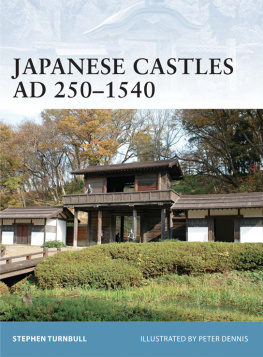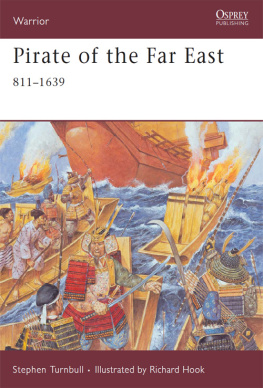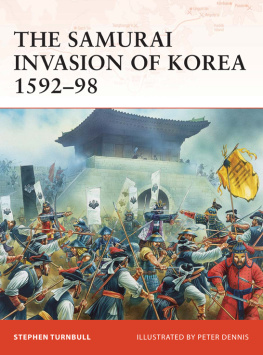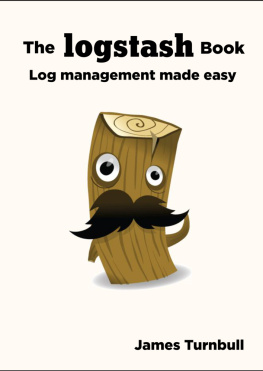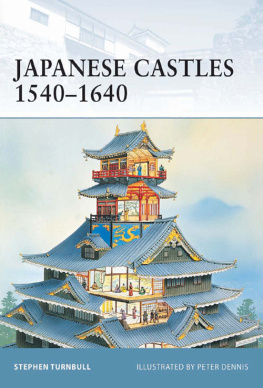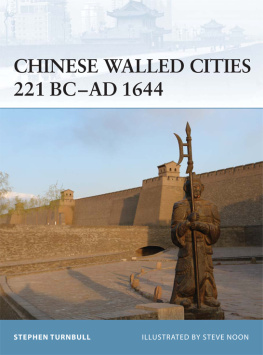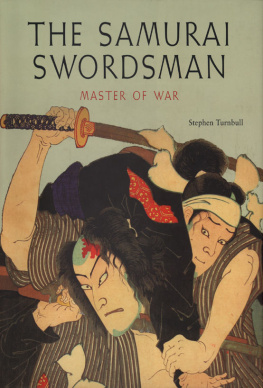A Greenhill Book
First published in 2006 by Greenhill Books, Lionel Leventhal Limited
www.greenhillbooks.com
This edition published in 2018 by
Frontline Books
An imprint of
Pen & Sword Books Ltd
Yorkshire - Philadelphia
Copyright Stephen Turnbull, 2006
ISBN: 978-1-52671-375-9
eISBN: 978-1-52671-377-3
Mobi ISBN: 978-1-52671-376-6
All rights reserved. No part of this publication may be reproduced, stored in or introduced into a retrieval system, or transmitted, in any form, or by any means (electronic, mechanical, photocopying, recording or otherwise) without the prior written permission of the publisher.
CIP data records for this title are available from the British Library
Maps drawn by Derek Stone
For more information on our books, please visit
For a complete list of Pen & Sword titles please contact
PEN & SWORD BOOKS LTD
47 Church Street, Barnsley, South Yorkshire, S70 2AS, England
E-mail:
Website: www.pen-and-sword.co.uk
Or
PEN AND SWORD BOOKS
1950 Lawrence Rd, Havertown, PA 19083, USA
E-mail:
Website: www.penandswordbooks.com
List of Illustrations
Plates
Theodosian walls of Constantinople
The medieval walls of Belgrade
The army of the Swiss confederacy in 1476
Pay day for mercenaries
The walls of the church of San Juan de los Reyes in Toledo
Boabdil hands over the keys of Granada on 2 January 1492
Gonzalo Fernndez de Crdoba El Gran Capitn
Gaston de Foix
The Battle of Marignano
Emperor Charles V
Diorama of the Battle of Pavia in 1525
The rocca of Imola in Italy
The Tower of St George in Rhodes
The Battle of Lepanto in 1571
The death of King Louis of Hungary
The recovery of King Louiss body
The heroism of the women of Erlau
The castle of Sarzanello
The ravelin at Sarzanello
The castle of Kuressaare
The church of St George of the Greeks at Famagusta
The armour of King Henry VIII of England
A three-quarter field armour of about 1600
A knight with a wheel-lock pistol
A reiter in action with his pistol
The moat of Kuressaare Castle in Estonia
The sack of Naarden
The governor of Leiden during the siege of 1574
The relief of Leiden
The walls of the Pskov Kremlin
The icon of Pskov
Hetman Zolkiewski during the Battle of Cecora in 1620
The relief of the Kremlin in 1612
The Battle of Kerestes in 1596
The Siege of Kanicsa in 1600
Line Art
A square of Swiss pikemen
The moment of interaction between two pike units
King Francis I of France
Suleiman the Magnificent
The defences of Rhodes between 1480 and 1522
Sixteenth-century gunners in action
A Venetian galley, as used in 1571
The castle of Djerba
Khereddin Barbarossa
Andrea Doria
The abortive Siege of Algiers in 1541
Don John of Austria
John Szapolyai
Grand Vizier Ibrahim Pasha
Ferdinand Habsburg
Miklos Zrinyi
The final sally from Szigeth by Zrinyi and his men
A plan of the walls of Nicosia
The French knight Bayard
The death of Bayard
Blaise de Monluc
The Battle of Dreux in 1562
The external parts of a wheel-lock pistol
Elector John Frederic of Saxony
The Battle of Mhlberg in 1547
The Battle of Heiligerlee in 1568
The demolition of the Antwerp citadel in 1577
Alexander Farnese, Duke of Parma
Parmas bridge across the Scheldt at Antwerp
The battle for the Kowenstyn dyke
Stefan Bathory, King of Poland
The Siege of Smolensk
The Siege of Komarno in 1594
Captain John Smith
Maps
Europe, 14531618
Western Mediterranean: The naval contest, 14831571
The Dutch Revolt, 15661600
Introduction
Renaissance and Revolution?
I n 1438 a traveller from Spain called Pero (Pedro) Tafur visited the great city of Constantinople, where he shared with its citizens a rather exciting moment when the Ottoman sultan passed close to the walls:
During my stay in the city the Turk marched forth to a place on the Black Sea, and his road took him close to Constantinople. The Despot and those of Pera, thinking that the Turks were going to occupy the country, prepared and armed themselves. The Turk passed close by the wall, and there was some skirmishing that day close to the wall, and he passed with a great company of people. I had the good fortune to see him in the field, and I observed the manner in which he went to war.
Tafurs good fortune had in fact provided him with what proved to be the last sighting of an Ottoman army near Constantinople prior to the great siege of 1453. In that fateful year a much larger army returned and surrounded the city, and as a result more than a thousand years of the Byzantine Empire came dramatically to an end in what has long been regarded as one of the pivotal events in world history. A new chapter had been opened, and in the most dramatic hyperbole of all it was reckoned that the knightly and chivalric world of the Middle Ages had finally ended. The period of creativity in both art and warfare that we know as the Renaissance was about to begin.
The modern world tends to take a rather different view of the significance of the fall of Constantinople. Instead of standing on the walls with Pero Tafur, and seeing something approaching that appears to be alien, threatening and mysterious, the modern scholar looks down on a map and discovers that even fifty years before the siege the Ottoman Empire already stretched from central Anatolia to the borders of Hungary, taking in Bulgaria and much of northern Greece. If distinctive colours are used on the map to show who controls which bit of territory, then the relative insignificance of Constantinople becomes even more apparent. The Ottoman Empire is now one wide splash of uniform colour, broken only by small contrasting patches that represent trading colonies such as Genoese Pera, but of Constantinople and its great Byzantine Empire there is little sign other than a black dot representing one city.
This book is concerned with the changes in warfare that occurred between the fall of Constantinople and the outbreak of the Thirty Years War. As change in warfare is almost always ongoing, any choice of dates must be somewhat arbitrary and in need of justification. I have chosen to cover almost exactly the same period of a century and a half that was used by J. R. Hale in his classic study War and Society in Renaissance Europe 14501620. The present work, therefore, describes warfare as it was fought during the period that lay between the end of Europes longest conflict and the beginning of Europes worst.










